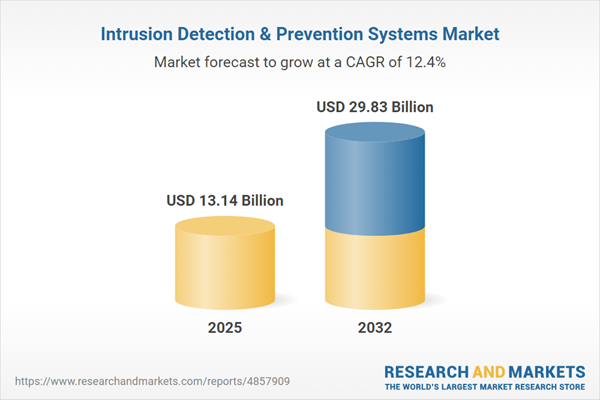Speak directly to the analyst to clarify any post sales queries you may have.
Intrusion detection and prevention systems are central to modern enterprise cybersecurity strategies, supporting proactive defense and compliance across diverse operational landscapes. As organizations face mounting digital risks and regulatory complexity, leaders are seeking adaptable solutions that strengthen both security posture and business agility.
Market Snapshot: Global Intrusion Detection and Prevention Systems Market
The global intrusion detection and prevention systems market is valued at USD 11.70 billion, with projected growth reaching USD 13.14 billion by 2025 and a robust CAGR of 12.40% through 2032.
Core market dynamics include escalating cloud adoption, heightened demand for comprehensive and integrated security platforms, and intensifying industry-wide focus on compliance and risk management. Large enterprises and mid-market organizations are compelled by digital transformation projects and increasingly intricate IT environments to prioritize unified cybersecurity management. Buying decisions are shaped by the need to optimize threat response, streamline security operations, and support ongoing regulatory requirements.Scope & Segmentation of the Intrusion Detection and Prevention Systems Market
This report equips IT and security leaders with actionable insights for evaluating investments in intrusion detection and prevention systems. Its segmentation framework is designed for aligning technology deployments, enhancing organizational resilience, and fine-tuning defenses to suit industry-specific risk profiles and operational needs.
- Component: Hardware, software, and service solutions address varying cybersecurity maturity levels and deployment preferences within enterprises.
- Solution Type: Unified platforms deliver centralized visibility and integrated incident management, supporting organizations with distributed or complex networks.
- Deployment: Cloud, on-premise, and hybrid models offer essential flexibility, enabling leaders to select security approaches that fit operational, regulatory, and resource conditions.
- End User Industry: Tailored approaches meet regulatory and threat requirements in sectors such as financial services, government, healthcare, defense, telecommunications, manufacturing, energy, IT, and retail.
- Organization Size: Solutions are calibrated for the unique scale, risk tolerance, and resourcing realities of large enterprises, mid-sized firms, and small businesses.
- Detection Technique: Anomaly-based, signature-based, and stateful protocol analysis techniques underpin adaptive, layered defenses against evolving attack methods.
- Region: Regional distinctions in regulation and adoption—across the Americas, Europe, Asia-Pacific, and Middle East & Africa—drive demand for regionally optimized solutions and compliance strategies.
- Major Vendors: Leading providers such as Cisco, Fortinet, Palo Alto Networks, Check Point, Juniper Networks, IBM, Huawei, Trend Micro, McAfee, and SonicWall adapt offerings in response to changing enterprise priorities and compliance landscapes.
Key Takeaways for Decision-Makers
- Artificial intelligence and machine learning now play a pivotal role in countering complex and previously undetected cyber threats, supporting more adaptive security responses.
- Flexible architectures help organizations rapidly align security capabilities to operational changes, especially during enterprise digital transformation initiatives.
- Improved interoperability among security platforms boosts unified monitoring and incident response across interconnected business environments and distributed networks.
- Automating security processes—paired with upskilling security teams—enables businesses to address growing threat volumes while controlling resource demands.
- Managed security service providers supply real-time threat intelligence, helping enterprises keep their defense strategies updated and responsive to new attack methods.
Tariff Impact: 2025 U.S. Regulatory Shifts
Emerging U.S. tariff regulations are prompting enterprises to revisit hardware sourcing for intrusion detection and prevention system investments. This shift is accelerating consideration of software-centric and virtualized alternatives, encouraging supply chain diversification, reinforcing domestic production options, and strengthening engagement with strategic suppliers.
Methodology & Data Sources
The report methodology combines executive interviews, sector-specific benchmarks, validated supplier data, and peer survey findings. All insights are reviewed via industry forums to ensure transparency and analytical integrity throughout the research process.
Why This Report Matters
- Enables IT leaders to refine security strategies by leveraging timely, verified market intelligence specific to intrusion detection and prevention systems.
- Supports thorough supplier benchmarking and robust risk analysis, facilitating the design of resilient cybersecurity frameworks for varied organizational scenarios.
- Guides strategic planning and policy development to address emerging compliance requirements and the expanding digital presence of enterprises.
Conclusion
By synthesizing market intelligence and strategic insights, this report helps executives make well-informed decisions to strengthen security and guide technology investments amid a rapidly evolving threat landscape.
Additional Product Information:
- Purchase of this report includes 1 year online access with quarterly updates.
- This report can be updated on request. Please contact our Customer Experience team using the Ask a Question widget on our website.
Table of Contents
3. Executive Summary
4. Market Overview
7. Cumulative Impact of Artificial Intelligence 2025
List of Figures
Companies Mentioned
The companies profiled in this Intrusion Detection & Prevention Systems market report include:- Cisco Systems, Inc.
- Fortinet, Inc.
- Palo Alto Networks, Inc.
- Check Point Software Technologies Ltd.
- Juniper Networks, Inc.
- International Business Machines Corporation
- Huawei Technologies Co., Ltd.
- Trend Micro Incorporated
- McAfee, LLC
- SonicWall Inc.
Table Information
| Report Attribute | Details |
|---|---|
| No. of Pages | 187 |
| Published | November 2025 |
| Forecast Period | 2025 - 2032 |
| Estimated Market Value ( USD | $ 13.14 Billion |
| Forecasted Market Value ( USD | $ 29.83 Billion |
| Compound Annual Growth Rate | 12.4% |
| Regions Covered | Global |
| No. of Companies Mentioned | 11 |









